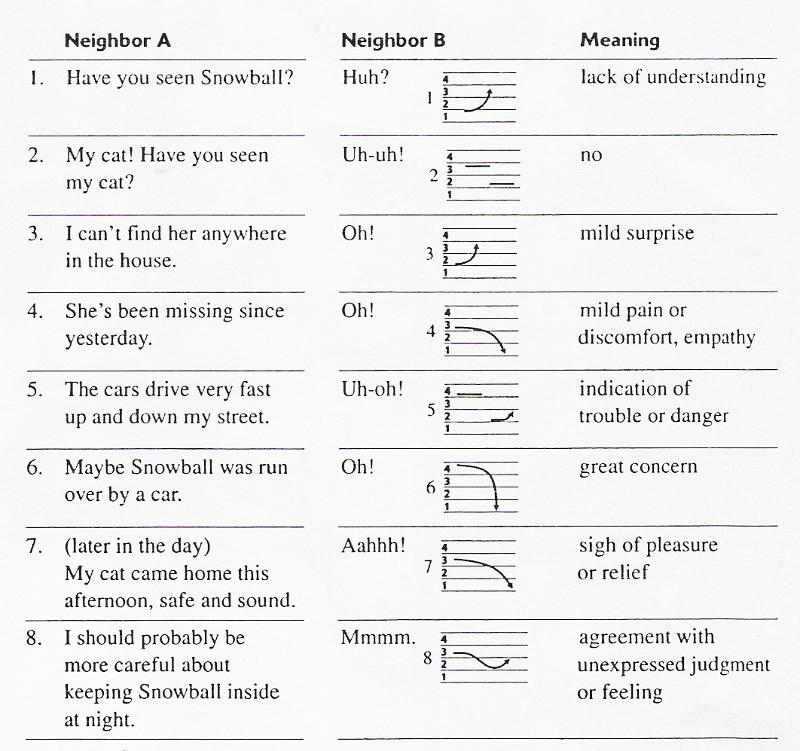
Intonation
Lesson 6

Intonation is the rise and fall in the pitch of the voice.
We have discussed pitch change, the voice going higher and lower, when stressing words or syllables in a sentence.
There are generally four levels of pitch in an English sentence or question. They are like musical notes.
|
Level 4 Extra high pitch |
~emphasis and contrastive stress ~strong emotions such as surprise, anger, elation or disbelief |
|
Level 3 High pitch |
~stressed words and syllables ~the ends of questions and thought groups with rising pitch |
|
Level 2 Middle-low pitch |
~unstressed words and syllables ~reductions with schwa vowels |
|
Level 1 Extra-low pitch |
~the ends of most sentences ~the completion of a speakers turn talking |
Here is an English sentence. Listen to the pitch change.
3____________go__________________________
2____I'm__________________________________
1__________________ing.___________________
Here is an example of a yes/no question:
3____________________ing?________________________
2_____Are they__go______________________________
1________________________________________________
Here is an example of a wh-question:
3__Where_______________________go_______________
2_______ __are they_______________________________
1_____________________________________ing?________
Here is an example of a sentence using contrastive stress:
4_________________tea_____________c__________________
3______wan______________not________o_________________
2__I_______ted_________________________k______________
1________________________________________e.___________
Listen to these statements. Do you hear rising or falling intonation at the ends of these statements?
1. I need to do my homework.
2. Call me a little later.
3. She's from Boston.
4. She doesn't want to go.
5. Record your voice in the voice board.
What's the rule?
In statements the voice rises on the last content word, and then falls to level one. This tells the listener that you have completed your sentence. This is called rising/falling intonation.
Listen to these yes/no questions. Do you hear rising or falling intonation at the ends of these questions?
1. Do you like coffee?
2. Are you from Maryland?
3. Hasn't she finished yet?
4. Will I see you soon?
5. Should we go now?
What's the rule?
In a yes/no question, the voice rises on the last stressed syllable and continues on the high tone to the end of the question. This is called rising/rising intonation.
Listen to these information questions. Do you hear rising or falling intonation at the ends of these questions?
1. Where are you from?
2. How many do you have?
3. When will they arrive?
4. Why didn't she go?
5. How much does it cost?
What's the rule?
In wh-questions, the voice rises on the last stressed syllable, but then falls to level 1 for the end of the question. This is called rising/falling intonation.
Download the following worksheet: "Basic Intonation Patterns" and decide if the statements and questions have rising/falling or rising/rising intonation. Record the sentences in the voice board: "Basic Intonation Patterns."
We change basic patterns of intonation when we:
When the speaker offers a choice, the voice rises on the first choice and rises/falls on the second choice. Roll your mouse over the text to see the rising and falling arrows. Listen and repeat.
Would you like coffee or tea?
Do you prefer chocolate or vanilla?
Is it upstairs or downstairs?
Will she stay or go?
Do you want your exam grade or your course grade?
When a speaker lists two or more items in a series, the pitch rises on the stressed syllable of every item except the last. The rise communicates that there is "more to come," and the fall communicates "the end."
While you're at the store please pick up bread, milk, and eggs.
On my sandwich, I would like mustard, lettuce, and tomatoes.
The apartment has a kitchen, a living room, two bedrooms, and a bathroom.
![]()
Practice placing your order at a Subway by listing the items you'd like on your sandwich (ham, mustard, etc.). Be sure to let your voice fall at the end so I know you've finished. Record your order in the voice board "Subway."
In this example, how does speaker Y indicate surprise?
X: She has twelve cats.
Y: She has twelve cats?
The Rule:
You can show surprise or disbelief by using rising pitch to echo a statement. The pitch rise is usually on the stressed syllable of the last content word.
Predict the rising or falling patterns in the dialogues below. Roll your mouse over the words to see the answers. When you are finished, listen to the speaker and repeat the dialogues.
Conversation 1
X: I failed biology.
Y: You failed biology?
Conversation 2
X: John was in an accident.
Y: He was in an accident? Was he hurt?
Conversation 3
X: My parents are letting me go to the beach.
Y: They're letting you go?
If you are not sure of what someone said and want clarification or repetition of a specific item, the pitch rises on the item you want clarified. Listen and repeat.
X: I live on 809 Main Street.
Y: You live on 809? (I'm not sure about "8")
X: My email is ehicks@howardcc.edu.
Y: g-hicks?
X: No, E hicks.
Listen to these two dialogues. Why did speaker X answer the same question in two different ways?
Dialogue 1
X: I'm going to Europe.
Y: Where?
X: France.
Dialogue 2
X: I'm going to Europe.
Y: Where?
X: Europe.
The Rule: In a wh- question, if the pitch falls, the speaker is probably seeking more information. If the pitch rises, the speaker is asking you to repeat or clarify.
You will see a statement. Listen to the question and choose the correct response.

Pitch can carry meaning, even without words. In this short conversation between neighbors, Neighbor B uses intonation to communicate.
Listen closely and repeat.

Watch the following video. Listen for rising or falling intonation. Change the color to red when a word rises at the end of a sentence. Change the color to blue when it falls. You only need to do this to 20 lines of the script, but have fun listening and watching this short video. Submit through the assignments tool in CE6.
Download the script here.
Watch the video here.